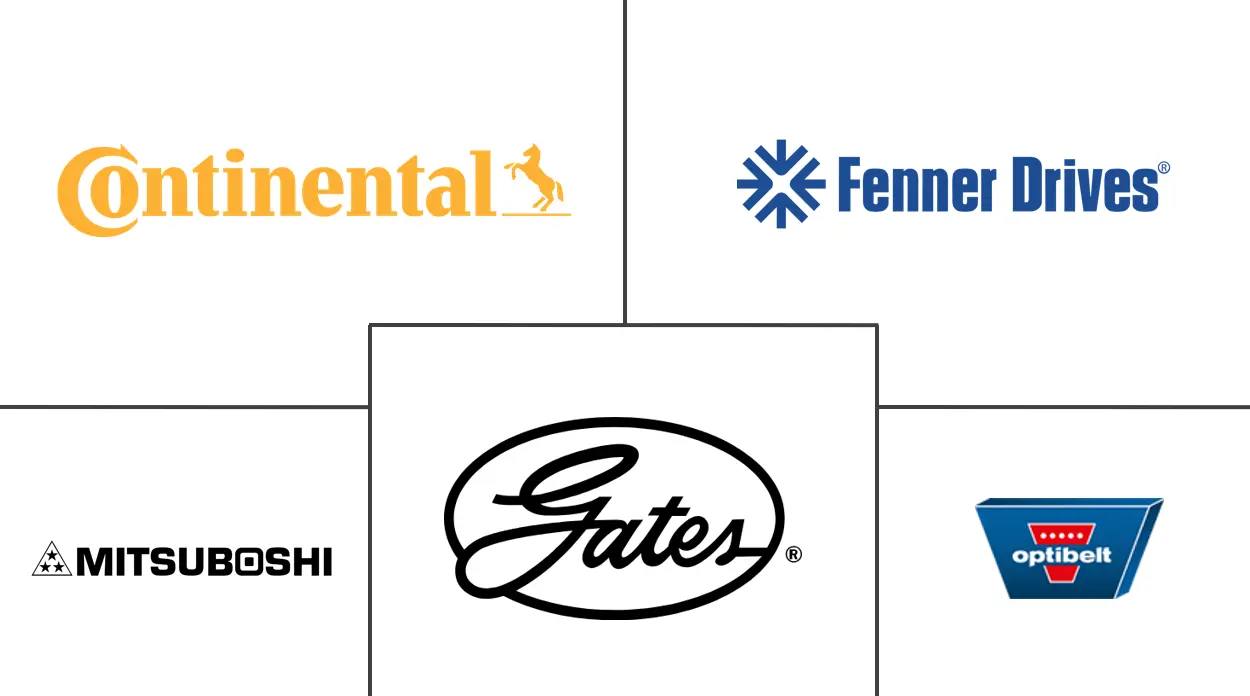Industrial V-Belt Market Size and Share
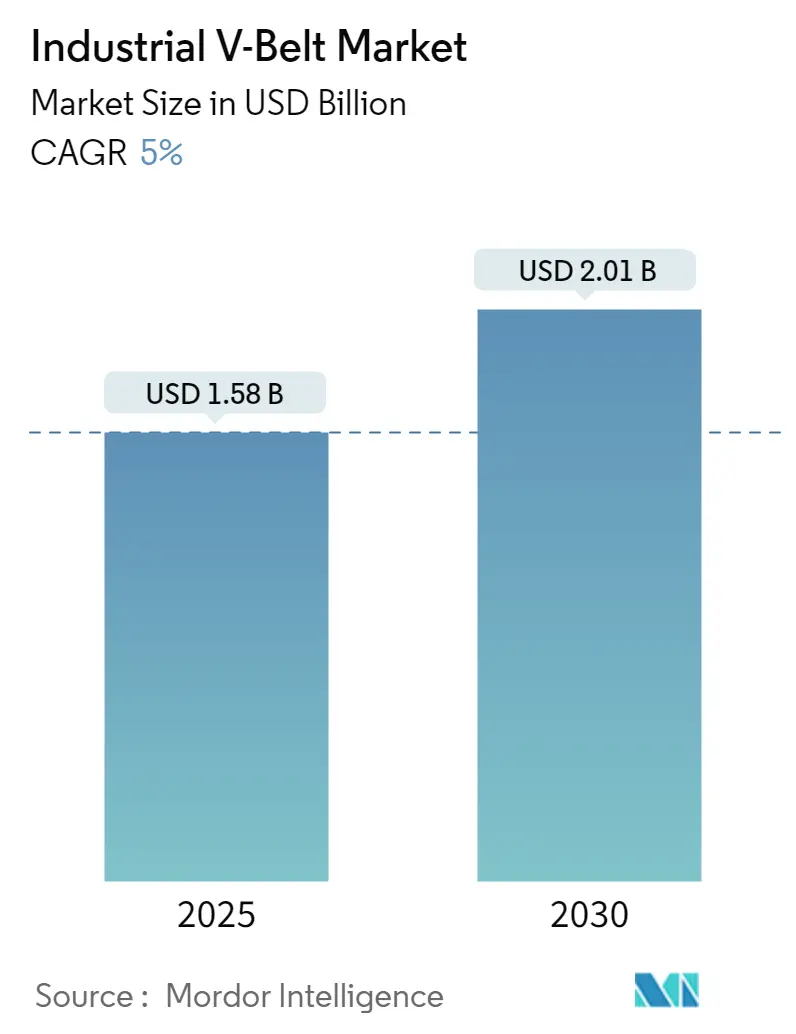
Industrial V-Belt Market Analysis by Mordor Intelligence
The Industrial V-Belt Market size is estimated at USD 1.58 billion in 2025, and is expected to reach USD 2.01 billion by 2030, at a CAGR of 5% during the forecast period (2025-2030).
- Industries are increasingly prioritizing energy conservation and operational efficiency. This shift has spurred the creation of high-efficiency V-belts designed to minimize energy losses through enhanced grip and reduced slippage. For instance, the Predator V-belts from Gates Corporation stand out for their resistance to oil, heat, and other challenging environmental factors, making them perfect for demanding situations. Notably, they can transmit up to 50% more power than standard belts.
- To boost the durability, flexibility, and temperature resilience of V-belts, manufacturers are turning to innovative materials such as polyurethane, carbon fiber, and specialized rubber compounds. This movement is especially pronounced in scenarios where belts face extreme conditions. For instance, composite V-belts are addressing challenges in HVAC systems, notably the shortened lifespan of V-belts under high temperatures.
- In response to rising demand, market manufacturers are boosting production capacities and upgrading facilities. The vulnerabilities of the global supply chain have spurred a shift toward regionalization and reshoring. A case in point: Dayco is set to bolster its North American footprint with a new facility in Mexico, slated for 2024.
- Despite its growth, the V-belt market contends with challenges, especially from the increasing adoption of alternative power transmission methods, such as synchronous belts. These alternatives are often preferred for their precision and minimal maintenance requirements. On another front, manufacturers are navigating stricter environmental regulations concerning emissions and material disposal, prompting a shift towards more sustainable product development.
- Asia-Pacific, with a spotlight on India and China, is witnessing rapid industrialization, serving as a significant catalyst for the V-belt market. Bolstered by foreign direct investment (FDI) and government-led infrastructure initiatives, the region's automotive and mining sectors are thriving. This growth, coupled with a broader industry shift toward automation, is fueling a strong demand for industrial V-belts.
Global Industrial V-Belt Market Trends and Insights
The Automotive Industry is Projected to Witness Strong Demand
- The rise of electric vehicles (EVs) has prompted a shift in demand for V-belts. Traditional V-belts have been predominantly used in internal combustion engine (ICE) vehicles for functions like alternators, water pumps, and HVAC systems. However, with the advent of EVs, there is an increasing need for V-belts in auxiliary systems, including air conditioning compressors and battery cooling systems. This trend toward electrification is pushing manufacturers to innovate V-belts tailored for EV powertrains, which have distinct operational characteristics compared to their traditional counterparts.
- As automotive manufacturers increasingly prioritize energy efficiency and emission reductions, V-belts have emerged as pivotal components. They ensure minimal energy loss by enhancing grip and reducing slippage in power transmission systems. To align with the industry's focus on curbing fuel consumption and carbon emissions, manufacturers are developing high-efficiency V-belts using advanced materials like aramid fibers and synthetic rubber compounds, boosting durability and operational efficiency.
- Moreover, with consumers becoming more attuned to comfort and driving experiences, automakers are prioritizing the reduction of noise, vibration, and harshness (NVH) in vehicles. Innovations in V-belt design, such as noise-reducing coatings and specialized grooves, are aiding automotive manufacturers in minimizing operational noise.
- For example, Gates Corporation, a frontrunner in automotive drive belts, partners with original equipment (OE) manufacturers worldwide. This collaboration ensures the continuous enhancement of belt drive performance and durability. Gates Corporation's belts, featuring aramid tensile cords, are designed for longevity and effectively mitigate the noise and vibration typically associated with these drives.
- The move toward hybrid powertrains, which combine electric and ICE components, has necessitated the development of hybrid V-belts. These belts are designed to function across a range of temperatures and loads, accommodating the varying demands of hybrid engines. The automotive sector's rebound has led to a rise in demand for V-belts as manufacturers ramp up production to meet market demand, which is driving the market.
- Countries like India are leading the charge in automotive manufacturing, with the size of the automotive components industry growing consistently and reaching USD 74.1 billion in FY2024, according to data published by the Automotive Component Manufacturers Association of India. These factors are anticipated to create new market opportunities.
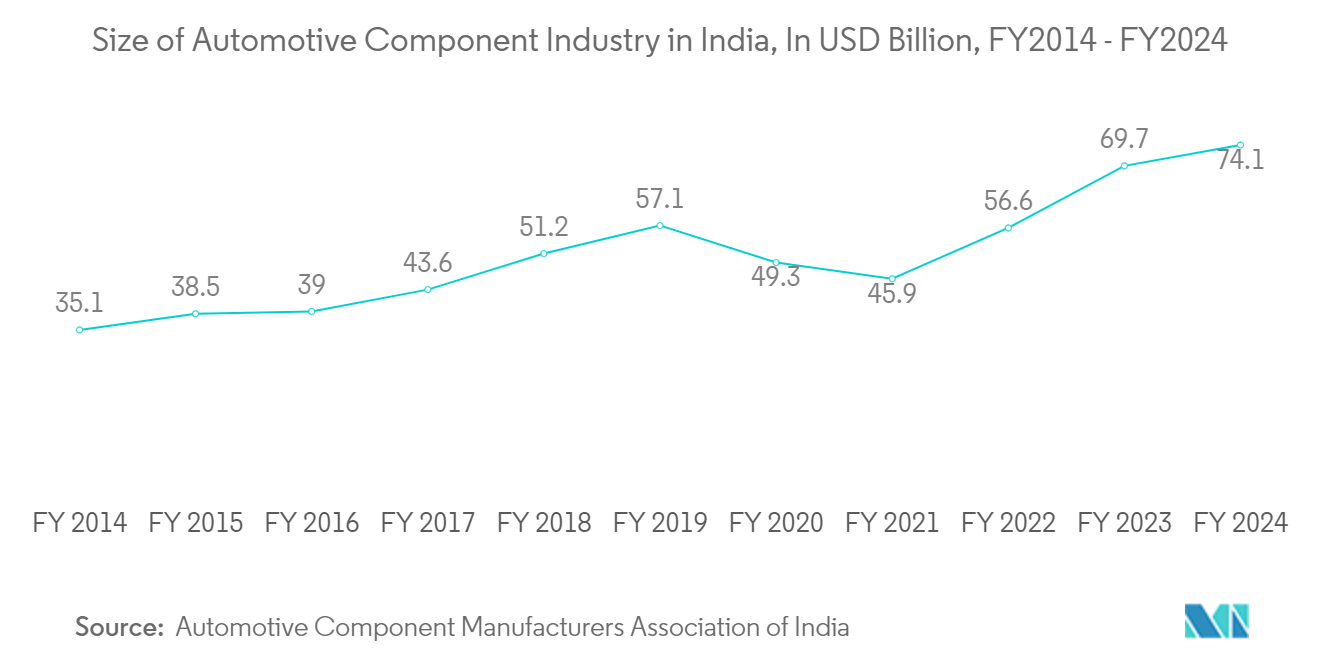
Asia-Pacific is Expected to Register a Significant Share in the Market
- Countries such as China, India, and Vietnam are rapidly industrializing, leading to an expansion of manufacturing facilities across diverse sectors. Industrial V-belts are crucial in machinery for industries including textiles, food processing, mining, and steel production. As these nations develop large-scale manufacturing ecosystems, there is a heightened demand for durable, high-performance V-belts to ensure continuous operations.
- The region is home to some of the world's largest automotive manufacturers. The surge in vehicle production, particularly in emerging economies, is driving up the demand for industrial V-belts in automotive systems. Furthermore, countries like China, India, and South Korea are making significant investments in industrial automation and smart manufacturing, both of which are pivotal growth areas for industrial V belts.
- The Indian manufacturing sector is on track to become one of the fastest-growing segments of its economy. Through initiatives like 'Make in India,' the government aims to bolster the country's manufacturing footprint, offering local manufacturers enticing government incentives.
- State governments are actively competing to attract new manufacturing units, offering a variety of incentives. Data from MOSPI (National Statistical Office) and the Department for Promotion of Industry and Internal Trade (India) reveal that the manufacturing sector saw a production growth rate of 4.7% in FY2023.
- Countries like Indonesia, Thailand, and Australia heavily depend on their agricultural and mining sectors, which rely on industrial machinery using V-belts for power transmission. As these industries become more mechanized, the demand for high-performance belts remains steady. India is making significant strides in mining, with plans to triple underground coal mining to meet its energy demands, as stated by the Indian Ministry. Such developments are poised to propel the market's growth.
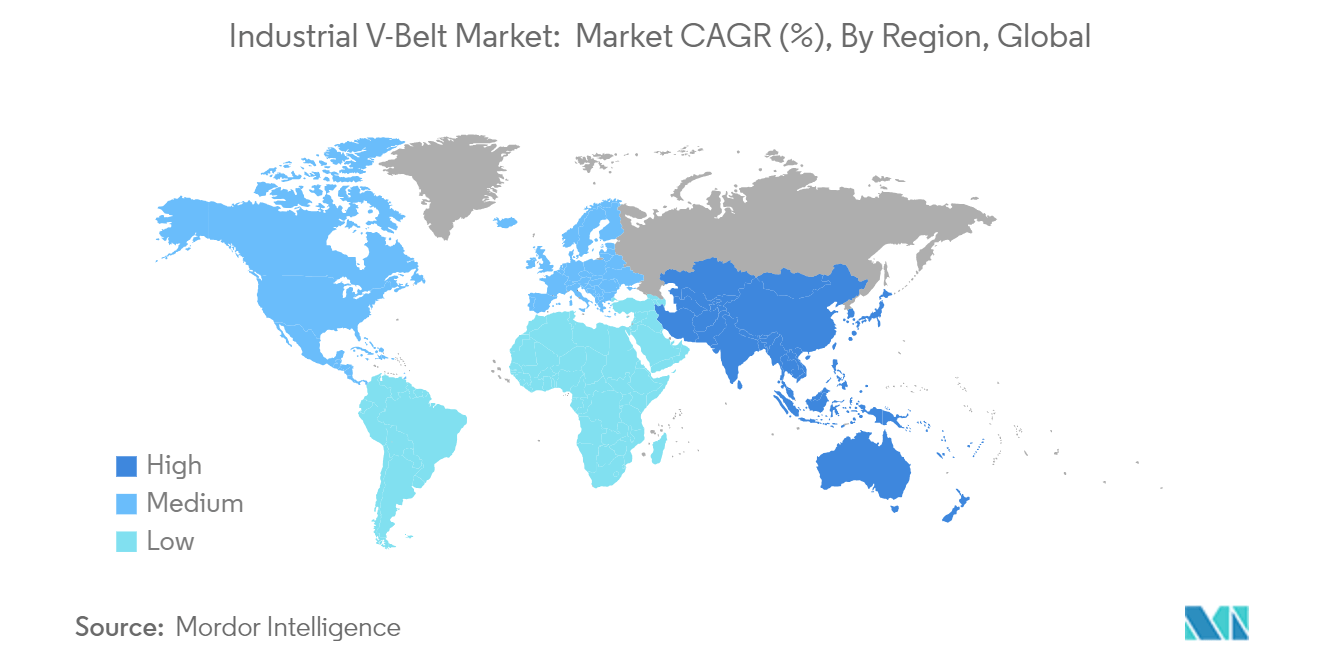
Competitive Landscape
The market features a mix of global giants and regional players, with competition driven by product innovation, technological advancements, price competitiveness, and strategic expansion. It is a fragmented landscape, with numerous manufacturers providing a diverse array of V-belts for industries like automotive, manufacturing, agriculture, mining, and construction. The key market players include Continental AG, Gates Corporation, Hutchinson, SFK, and Fenner Drives. These companies capitalize on their vast product portfolios, global distribution networks, and innovative prowess. To stay ahead, manufacturers are honing in on advanced materials for their V-belts. Furthermore, players are carving out niches by specializing in offering V-belts tailored to specific industries or applications.
With a growing emphasis on sustainability across industries, companies are urged to pivot toward eco-friendly production. This includes utilizing recyclable materials and minimizing emissions. By crafting green V-belts with extended lifecycles and reduced environmental footprints, companies can meet customer demands and regulatory standards and bolster their market competitiveness. Moreover, addressing unique customer needs can set companies apart from competitors offering more generic products. Thus, a balanced approach that intertwines innovation, sustainability, operational efficiency, and market expansion is essential.
Industrial V-Belt Industry Leaders
Gates Corporation
ContiTech Deutschland GmbH
Mitsuboshi Belting Ltd
Fenner Drives, Inc.
Optibelt GmbH
- *Disclaimer: Major Players sorted in no particular order
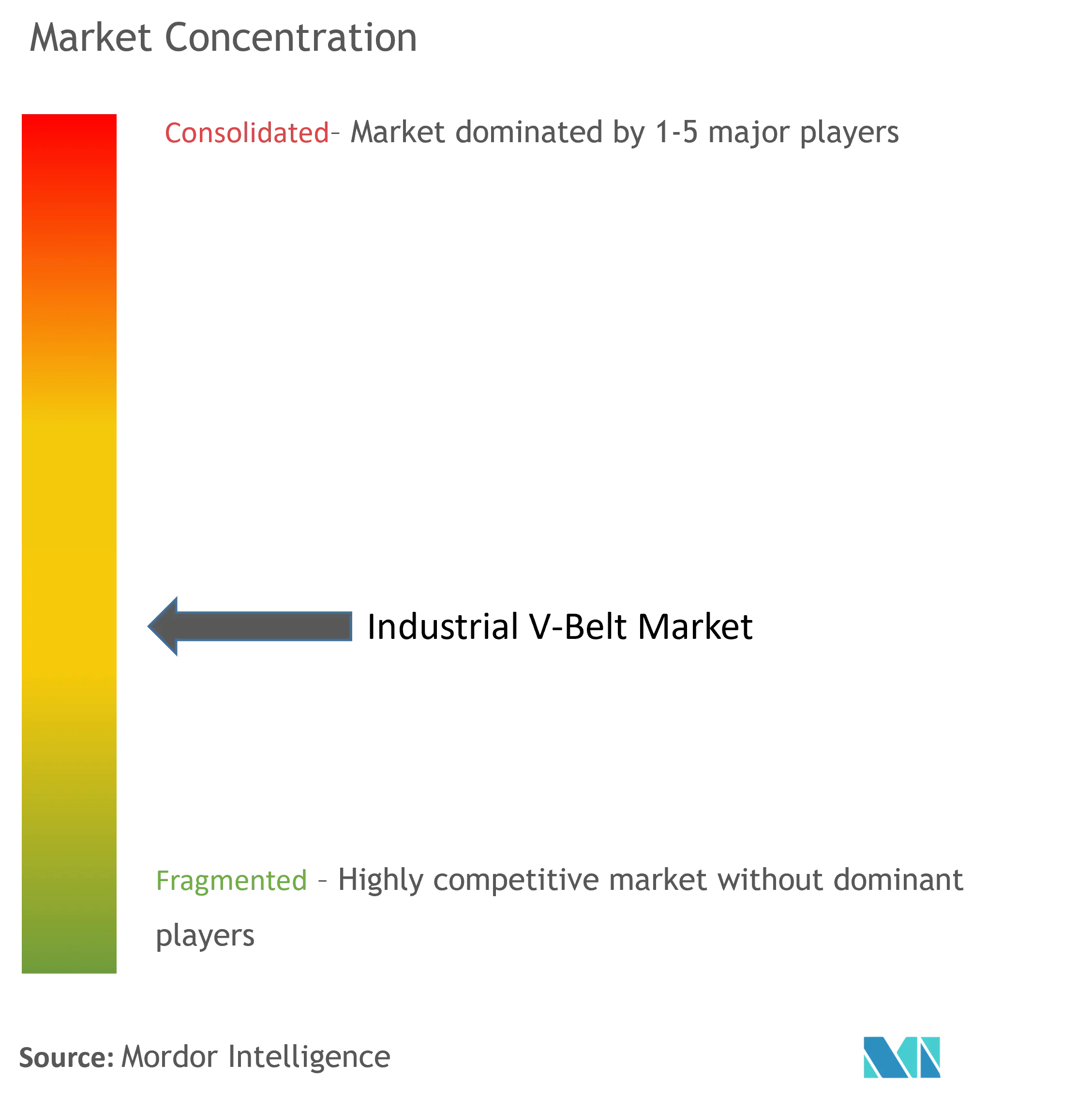
Recent Industry Developments
- August 2024: Gates Corporation is enhancing its bandless V-belt lineup. The composition of the Super High Capacity (HC) Molded Notch (MN) V-belt will transition from standard chloroprene rubber (CR) materials to advanced ethylene elastomer (EE) compounds. Furthermore, in July 2024, the company began producing its EE Tri-Power V-belts in Europe, ensuring reduced lead times and improved availability.
- March 2024: V-Belt manufacturer Dayco Inc. inaugurated its new plant in San Luis Potosí, Mexico, located in the Tres Naciones Park, in the Industrial Zone of the state. The new plant will be used to produce belts for light combustion cars, with its molded tooth design that operates more quietly and efficiently. In terms of its scale and capacity, the facility covers 73,000 sq. ft and is equipped with state-of-the-art machinery that can produce up to 4.2 million Poly-V belts annually,
Global Industrial V-Belt Market Report Scope
An industrial V-belt is a type of mechanical belt used in machinery to transmit power between rotating shafts, typically from a motor to a pulley. It has a V-shaped cross-section, which allows it to fit snugly into pulley grooves, providing strong traction and reducing slippage. V-belts are known for their efficiency, durability, and ability to handle high loads, making them essential in various industrial applications.
The study tracks the revenue generated from the sale of industrial V-belts by various manufacturers worldwide. It also tracks the key market parameters, underlying growth influencers, and major manufacturers operating in the industry, which supports the market estimations and growth rates during the forecast period. The study further analyses the overall impact of macroeconomic factors on the market.
The industrial v-belt market is segmented by type (classical v-belt, narrow v-belt, wedge v-belt, and banded v-belt,) material (rubber v-belt, polyurethane v-belt, and neoprene v-belt), end-user vertical (automotive industry, agriculture, mining and quarrying, manufacturing, construction, and HVAC systems), and geography (North America, Europe, Asia-Pacific, Latin America, and Middle East and Africa). The market sizes and forecasts are provided in terms of value (USD) for all the above segments.
| Classical V-belt |
| Narrow V-belt |
| Wedge V-belt |
| Banded V-belt |
| Rubber Belt |
| Polyurethane V-belt |
| Neoprene V-belt |
| Automotive Industry |
| Agriculture |
| Mining and Quarrying |
| Manufacturing |
| Construction |
| HVAC Systems |
| North America |
| Europe |
| Asia |
| Australia and New Zealand |
| Latin America |
| Middle East and Africa |
| By Type | Classical V-belt |
| Narrow V-belt | |
| Wedge V-belt | |
| Banded V-belt | |
| By Material | Rubber Belt |
| Polyurethane V-belt | |
| Neoprene V-belt | |
| By End-user Vertical | Automotive Industry |
| Agriculture | |
| Mining and Quarrying | |
| Manufacturing | |
| Construction | |
| HVAC Systems | |
| By Geography*** | North America |
| Europe | |
| Asia | |
| Australia and New Zealand | |
| Latin America | |
| Middle East and Africa |
Key Questions Answered in the Report
How big is the Industrial V-Belt Market?
The Industrial V-Belt Market size is expected to reach USD 1.58 billion in 2025 and grow at a CAGR of 5% to reach USD 2.01 billion by 2030.
What is the current Industrial V-Belt Market size?
In 2025, the Industrial V-Belt Market size is expected to reach USD 1.58 billion.
Who are the key players in Industrial V-Belt Market?
Gates Corporation, ContiTech Deutschland GmbH, Mitsuboshi Belting Ltd, Fenner Drives, Inc. and Optibelt GmbH are the major companies operating in the Industrial V-Belt Market.
Which is the fastest growing region in Industrial V-Belt Market?
Asia Pacific is estimated to grow at the highest CAGR over the forecast period (2025-2030).
Which region has the biggest share in Industrial V-Belt Market?
In 2025, the Asia Pacific accounts for the largest market share in Industrial V-Belt Market.
What years does this Industrial V-Belt Market cover, and what was the market size in 2024?
In 2024, the Industrial V-Belt Market size was estimated at USD 1.50 billion. The report covers the Industrial V-Belt Market historical market size for years: 2019, 2020, 2021, 2022, 2023 and 2024. The report also forecasts the Industrial V-Belt Market size for years: 2025, 2026, 2027, 2028, 2029 and 2030.
Page last updated on:
Industrial V-Belt Market Report
Statistics for the 2025 Industrial V-Belt market share, size and revenue growth rate, created by Mordor Intelligence™ Industry Reports. Industrial V-Belt analysis includes a market forecast outlook for 2025 to 2030 and historical overview. Get a sample of this industry analysis as a free report PDF download.
